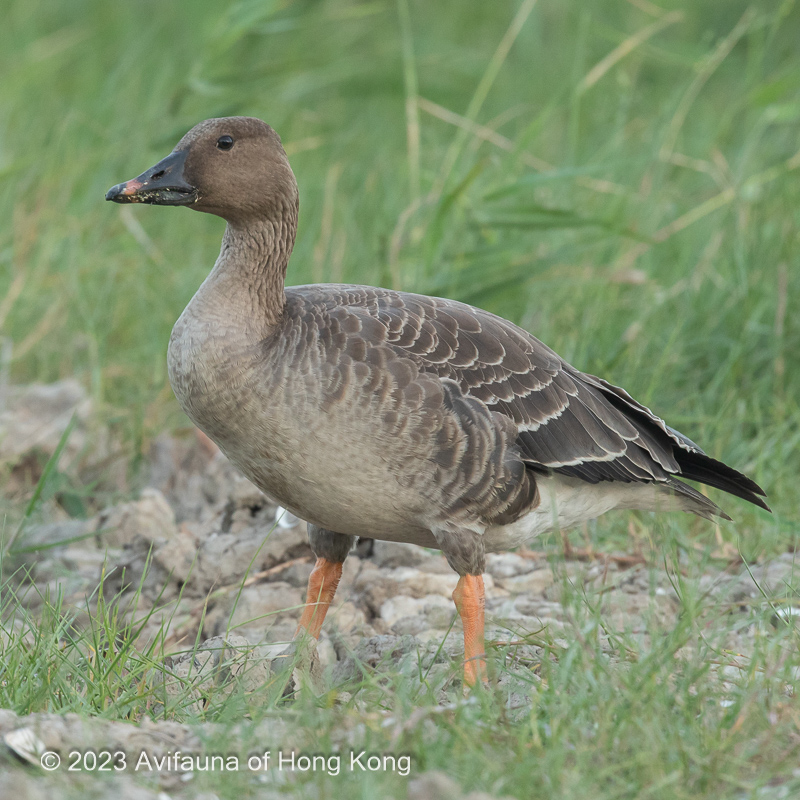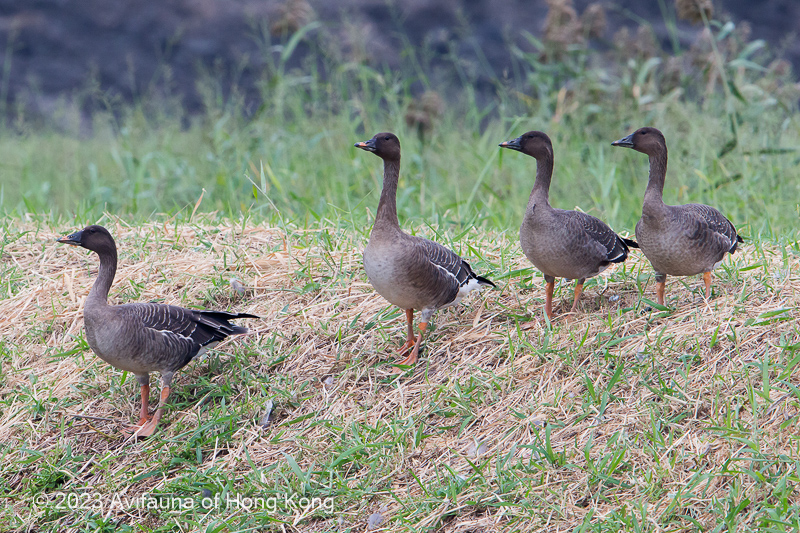Tundra Bean Goose Anser serrirostris 凍原豆雁
Category I. Accidental.
IDENTIFICATION

Nov. 2017, James Kwok.
66-80 cm. Closely resembles Taiga Bean Goose but typically differs in smaller size, shorter largely dark bill that has smaller subterminal orange patch, straight or convex culmen and short, bulbous nail, slightly paler underparts, shorter and less slender neck, shorter, more angular head that has a more rounded crown meeting a shorter bill.

Nov. 2013, Martin Hale.
The body is shorter and more squat than that of Taiga Bean Goose. Variation in bill pattern is illustrated well in this photograph.
VOCALISATIONS
Call generally more metallic, muffled and hollow than Taiga Bean Goose (Brazil 2018).
DISTRIBUTION & HABITAT PREFERENCE
With the exception of the first record, which was present on the intertidal mudflats, has generally occurred in freshwater and brackish gei wai and ponds.
OCCURRENCE
2009: one at Mai Po NR on 1 January (Lewthwaite 2012).
2010: one at Mai Po NR during 3-12 November.
2013: four at Tuen Mun / Long Valley / Lok Ma Chau from 27 October to 14 November.
2017: up to four (two adults, two juveniles) at Mai Po NR from 31 October to 8 December.
2020: five at Mai Po NR on 24 November.
BEHAVIOUR, FORAGING & DIET
No observations.
RANGE & SYSTEMATICS
Three subspecies are recognised, with that presumed to occur in Hong Kong being nominate serrirostris, which breeds in northeast Siberia; A.f. rossicus breeds in north Russia and northwest Siberia. Not all authorities split Taiga Bean Goose and A. serrirostris.
Breeds in tundra zone of north Russia east to Chukotka and winters in northern, northwest and central Europe and western Russia, and east Asia, the latter area supporting most of the population of nominate serrirostris. In China nominate serrirostris is a migrant through the north and northeast and winters in south central China though generally does not reach the coast; has occurred in Hainan and Taiwan (Liu and Chen 2020).
CONSERVATION STATUS
IUCN (treats A. fabalis and A. serrirostris as single species): Least Concern. Population trend decreasing.
Brazil, M. (2018). Birds of Japan. Helm, London.
Carboneras, C. and G. M. Kirwan (2020). Tundra Bean-Goose (Anser serrirostris), version 1.0. In Birds of the World (S. M. Billerman, B. K. Keeney, P. G. Rodewald, and T. S. Schulenberg, Editors). Cornell Lab of Ornithology, Ithaca, NY, USA. https://doi.org/10.2173/bow.tunbeg1.01
Lewthwaite, R. W. (2012). Tundra Bean Goose Anser serrirostris at Mai Po NR. The first Hong Kong record with notes on its historical status on the coast of Fujian and Guangdong. Hong Kong Bird Report 2009-10: 235-240
Liu, Y. and Y. H. Chen (eds) (2020). The CNG Field Guide to the Birds of China (in Chinese). Hunan Science and Technology Publication House, Changsha.

